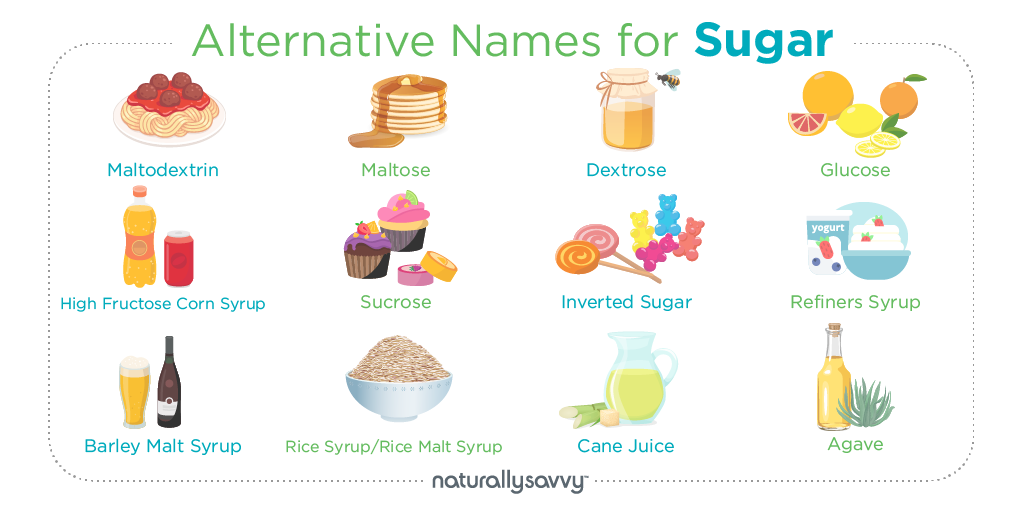
Sweet, sneaky sugar – you think you are so savvy hiding everywhere. Well, you had better watch out! We have the facts to find you, diminish you from our diets and feel better for it.
Deceivingly Sweet Everyday Foods
Many common food products contain a lot more sugar than you may have thought. Did you know the condiment you just applied to your food has sugar in it? And, as for that low-fat yogurt cup, it contains more than 5 teaspoons (20 grams) of sugar. In fact, low-fat foods are the worst culprit for containing unsuspectingly high amounts of sugar. Sugar tastes good, so it is added to almost every prepared food we eat. The result? Health professionals raising concerns that eating high amounts of simple sugar causes high blood sugar levels and weight gain, which are risk factors for diabetes.
How Much Sugar Are You Eating?
Deceiving and sneaky, sugar is hiding in all sorts of foods and drinks. In 2014, the average Canadian consumed about 26 teaspoons (110 grams) of sugar a day, according to Statistics Canada.
According to new World Health Organization guidelines published in 2014, we should only be eating about 6 teaspoons of sugar (25g) a day. To put that into context, a can of soda pop contains 9 teaspoons, and a half of a cup of packaged pasta sauce contains 2.5 teaspoons.
Read more about the dangers of artificial sweeteners
Deceptively Sugary Everyday Foods:
Low fat yogurt cup = 5 tsp of sugar
Granola bar = 2 ½ tsp of sugar
Peanut butter (1 tbsp) = ¼ tsp of sugar
Mayonnaise (1tbsp) = ¼ tsp sugar
Pasta sauce (½ cup) = 2 ½ tsp of sugar
Ketchup (1 tbsp) = 1 tsp of sugar
Applesauce cup, sweetened = 5 tsp of sugar
Bread (2 slices) = 1 ½ tsp of sugar
The Sugar Addiction
Sugar triggers a pleasurable and captivating sensation in the body that can become addictive. Scientifically, that delectable high we feel when we consume sugar is caused by the creation of dopamine, which our brain associates with reward and motivation. Studies show the same hit of dopamine caused by drugs of abuse occurs when we binge on sugar. It is no wonder we love sugar – it can be addictive.
Identifying Sugar
There are many forms of sugar. Most of us think of sugar as the white crystals we add to tea. Sugar is also in many foods from fruit juice to maple syrup. Yet, the sugar we do not notice we are eating is that hiding in prepared or processed foods.
Looking for sugar on food labels goes beyond looking for anything ending with the letters “ose” (e.g. sucrose, glucose). There are many ways sugar can be written on food labels: glucose-fructose, dextrose, evaporated cane juice, fruit juice concentrates, malt and rice syrup.

Deciphering Sugary Claims
- “Sugar-free” or “Sugarless” – contains less than 0.5g of sugar per serving.
- “No added sugars” – contains no added sugars such as concentrated fruit juice, glucose or fructose.
- “Unsweetened” – contains no added sugars or sweeteners (aspartame, sucralose).
- “Low in sugar” – contains at least 25% less sugar than a compared to a similar product.
High Fructose Corn Syrup
A commonly added sugar in processed foods, high fructose corn syrup is created by chemically changing it to have more fructose, causing it to be sweeter. High fructose corn syrup is sometimes deceivingly called “glucose-fructose” on food labels. Most commonly found in soda pop, it is also in fruit drinks, candied fruits, canned fruits, dairy desserts, flavored yogurts, cereals, baked goods and jellies.
Eating foods that contain high fructose corn syrup may cause digestive discomfort, as its altered structure is hard for the body to digest. According to Dieticians of Canada, high fructose corn syrup containing foods are high in calories and could lead to weight gain. Studies raise concerns about this sugar affecting risk factors for liver, diabetes and heart disease.
It may also affect brain cells. Researchers at the University of California in 2012, trained rats to successfully navigate a maze, then replaced their water with 15 per cent fructose syrup (soda is typically 12 per cent). After six weeks of the fructose syrup, the rats were slower to complete the maze. Furthermore, when the rat’s brains were dissected the researchers discovered the sugar disrupted synapses (relay chemical messages), affecting the ability of the brain to form memories.
What about Complex Carbohydrates?
Sugar also comes in more complicated structures we call complex carbohydrates. Plants use complex sugar structures called starch to store energy. Fiber is an even more complicated sugar structure. Soluble fiber, found in fruits and some vegetables, dissolves in water forming a gummy-paste that slows the digestion of food and can prevent blood sugar spikes. Insoluble fiber found in the husks of grains and peels of fruit, promotes regularity in the digestive system.
Consistent Blood Glucose
Maintaining a steady blood sugar level is important in preventing dizziness and weakness (low blood glucose) and fatigue (high blood glucose). Research has linked eating foods that cause high blood sugar levels with disease. For example, the Nurses Study followed over 75,000 women for a decade and illustrated that a diet that causes high blood sugar levels is linked with a high risk of coronary heart disease.
Eating well-balanced meals, rich in fresh, whole foods that contain complex carbohydrates (e.g. nuts, seeds, vegetables, fruit, whole grains) regularly can help control blood sugar levels. Recommend intakes of fiber from health organizations vary between 25-35 grams per day.
Which Foods Affect You the Most?
Scientists have tested various foods to see how they affect your blood sugar levels. Foods that cause rapid increases in blood sugar are said to have a high glycemic load (cake, iced coffee drinks, granola bars). Foods that contain complex carbohydrates and thus cause a slower and more desirable increase in blood sugar are called low glycemic foods (vegetables, nuts, seeds).
Sweeteners and Other Tricky Foods
Artificial sweeteners are commonly used in processed foods to increase sweetness while keeping calories low. Saccharin, aspartame, sucralose, are examples of artificial sweeteners. Artificial sweeteners are thought by the general public as a good choice for weight loss. However, according to an animal study published in 2013 issue of Appetite, both saccharin and aspartame induced greater weight gain than sucrose. It is thought that artificial sweeteners may interfere with the body’s ability to properly balance energy intake.
Natural Sugar Alternatives
Since it is not realistic to cut sugar out completely, give alternative sweeteners a try. There is stevia, xylitol, palm sugar and agave nectar – just to name a few. Some natural sugar alternatives do not elicit as high of a blood sugar roller coaster as conventional white sugar (sugar cane) – plus, they taste great!
Read more about natural sweeteners
The Many Ways to Write ‘Sugar’:
| agave nectar
brown sugar cane juice corn sweetener cane juice (crystalized, evaporated) date sugar dextrose fruit juice concentrates |
fructose
galactose glucose glucose-fructose high-fructose corn syrup honey lactose malt |
maltose
molasses raw sugar sucrose sweetened carob powder syrup (cane, corn, golden, malt, maple, rice) treacle turbinado |
Low Glycemic Foods:
| Berries
Cherries Orange Peach Kiwi Pear Plums |
Oatmeal
Whole grain pasta Bulgur Brown rice Garbanzo beans Kidney beans Split peas Lentils |
Chickpeas
Lima beans Unsweetened apple, orange, grapefruit juice Plain yogurt Soy milk Cow’s milk Stevia Dark chocolate (over 60% cocoa, no added sugar) |
High Glycemic Foods:
| Most dried fruits
Ripe bananas Dates Parsnips |
Potatoes
French fries French bread Bagels |
Most Breakfast Cereals
Doughnuts Soft drinks |
This article originally appeared on AllisonTannis.com.
References
Swithers SE and TL Davidson. A role for sweet taste: calorie predictive relations in energy regulation by rats. Behav Neurosci 2008 Feb; 122(1):161-73.
Liu, S. et al. A prospective study of dietary glycemic load, carbohydrate intake and risk of coronary heart disease intake. AJCN 2000;71(6):1455-1461.
Danby, FW. Nutrition and aging skin: sugar and glycation. Clin Dermatol 2010;28(4):409-11.
Dieticians of Canada – Truth About Sugar
Morgan RE. Does consumption of high-fructose corn syrup beverages cause obesity in children? Pediatr Obes 2013 Aug;8(4):249-54.
Bray, GA. Energy and fructose from beverages sweetened with sugar or high-fructose corn syrup pose health risk for some people. Adv Nutr 2013 Mar;4(2):220-5.
Langlois, K and D. Garriguet. Sugar Consumption Among Canadians of All Ages. Statistics Canada, 2014.
Fernanda de Matos, F. et al. Saccharine and aspartame, compared with sucrose, induce greater weight gain in adult Wistar rats, at similar total caloric intake levels. Appetite 2013, Jan;60(1):203-207.
Image: Angie Garrett










